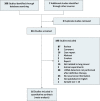Accuracy of minimal residual disease detection by circulating tumor DNA profiling in lung cancer: a meta-analysis
- PMID: 37173789
- PMCID: PMC10176776
- DOI: 10.1186/s12916-023-02849-z
Accuracy of minimal residual disease detection by circulating tumor DNA profiling in lung cancer: a meta-analysis
Abstract
Background: The sensitivity and specificity of minimal residual disease detected by circulating tumor DNA profiling (ctDNA MRD) in lung cancer, with particular attention to the distinction between landmark strategy and surveillance strategy, for predicting relapse in lung cancer patients after definitive therapy has yet to be determined.
Methods: The prognostic value of ctDNA MRD by landmark strategy and surveillance strategy was evaluated in a large cohort of patients with lung cancer who received definitive therapy using a systemic literature review and meta-analysis. Recurrence status stratified by ctDNA MRD result (positive or negative) was extracted as the clinical endpoint. We calculated the area under the summary receiver operating characteristic curves, and pooled sensitivities and specificities. Subgroup analyses were conducted based on histological type and stage of lung cancer, types of definitive therapy, and ctDNA MRD detection methods (detection technology and strategy such as tumor-informed or tumor-agnostic).
Results: This systematic review and meta-analysis of 16 unique studies includes 1251 patients with lung cancer treated with definitive therapy. The specificity of ctDNA MRD in predicting recurrence is high (0.86-0.95) with moderate sensitivity (0.41-0.76), whether shortly after treatment or during the surveillance. The landmark strategy appears to be more specific but less sensitive than the surveillance strategy.
Conclusions: Our study suggests that ctDNA MRD is a relatively promising biomarker for relapse prediction among lung cancer patients after definitive therapy, with a high specificity but suboptimal sensitivity, whether in landmark strategy or surveillance strategy. Although surveillance ctDNA MRD analysis decreases specificity compared with the landmark strategy, the decrease is minimal compared to the increase in sensitivity for relapse prediction of lung cancer.
Keywords: Diagnostic accuracy; Liquid biopsy; Lung cancer; MRD; ctDNA.
© 2023. The Author(s).
Conflict of interest statement
The authors declare that they have no competing interests.
Figures




Similar articles
-
ctDNA can detect minimal residual disease in curative treated non-small cell lung cancer patients using a tumor agnostic approach.Lung Cancer. 2025 May;203:108528. doi: 10.1016/j.lungcan.2025.108528. Epub 2025 Apr 4. Lung Cancer. 2025. PMID: 40220718
-
Perioperative ctDNA-Based Molecular Residual Disease Detection for Non-Small Cell Lung Cancer: A Prospective Multicenter Cohort Study (LUNGCA-1).Clin Cancer Res. 2022 Aug 2;28(15):3308-3317. doi: 10.1158/1078-0432.CCR-21-3044. Clin Cancer Res. 2022. PMID: 34844976
-
Identification of minimal residual disease using the clonesight test for ultrasensitive ctDNA detection to anticipate late relapse in early breast cancer.Breast Cancer Res. 2025 May 1;27(1):65. doi: 10.1186/s13058-025-02016-7. Breast Cancer Res. 2025. PMID: 40312346 Free PMC article.
-
Circulating Tumor DNA as a Real-Time Biomarker for Minimal Residual Disease and Recurrence Prediction in Stage II Colorectal Cancer: A Systematic Review and Meta-Analysis.Int J Mol Sci. 2025 Mar 11;26(6):2486. doi: 10.3390/ijms26062486. Int J Mol Sci. 2025. PMID: 40141130 Free PMC article.
-
Minimal residual disease in colorectal cancer. Tumor-informed versus tumor-agnostic approaches: unraveling the optimal strategy.Ann Oncol. 2025 Mar;36(3):263-276. doi: 10.1016/j.annonc.2024.12.006. Epub 2024 Dec 13. Ann Oncol. 2025. PMID: 39675560 Review.
Cited by
-
Circulating tumor DNA: current implementation issues and future challenges for clinical utility.Clin Chem Lab Med. 2023 Dec 19;62(11):2094-2110. doi: 10.1515/cclm-2023-1157. Print 2024 Oct 28. Clin Chem Lab Med. 2023. PMID: 38109307 Review.
-
Liquid biopsies for early detection and monitoring of cancer: advances, challenges, and future directions.Ann Med Surg (Lond). 2025 May 21;87(6):3244-3253. doi: 10.1097/MS9.0000000000002776. eCollection 2025 Jun. Ann Med Surg (Lond). 2025. PMID: 40486554 Free PMC article. Review.
-
Emerging Techniques of Translational Research in Immuno-Oncology: A Focus on Non-Small Cell Lung Cancer.Cancers (Basel). 2025 Jul 4;17(13):2244. doi: 10.3390/cancers17132244. Cancers (Basel). 2025. PMID: 40647543 Free PMC article. Review.
-
Early postoperative plasma circulating tumour DNA for molecular residue disease detection and recurrence risk evaluation in surgical non-small cell lung cancer.Clin Transl Med. 2024 Oct;14(10):e70056. doi: 10.1002/ctm2.70056. Clin Transl Med. 2024. PMID: 39394592 Free PMC article. No abstract available.
-
Towards zero lung cancer.Chin Med J Pulm Crit Care Med. 2023 Dec 11;1(4):195-197. doi: 10.1016/j.pccm.2023.10.006. eCollection 2023 Dec. Chin Med J Pulm Crit Care Med. 2023. PMID: 39171283 Free PMC article. No abstract available.
References
Publication types
MeSH terms
Substances
LinkOut - more resources
Full Text Sources
Medical

